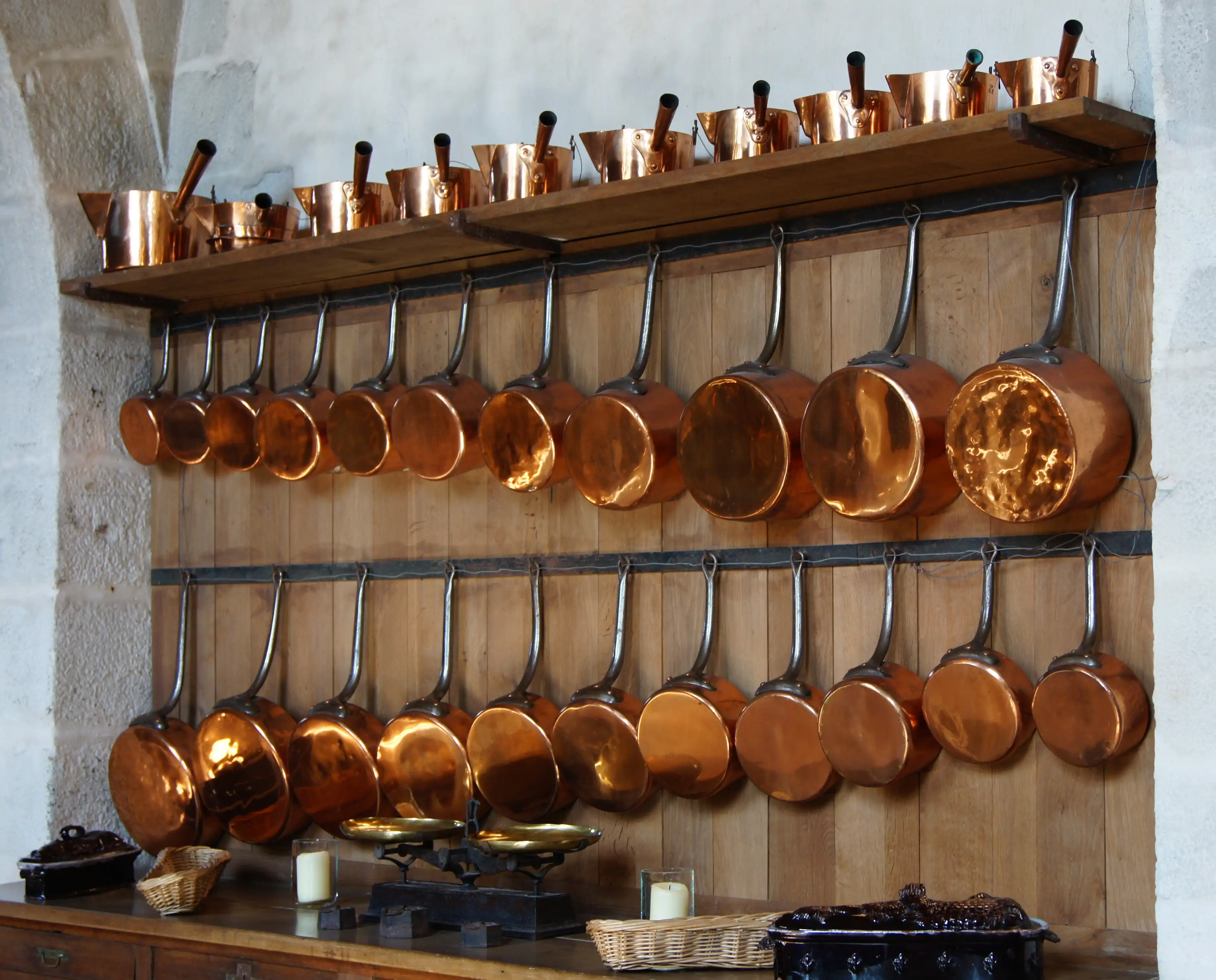Cookware |
 Casseroles cuivre Vaux |
Standards For Tools And Equipment
Selecting Tools And Equipment
Cookware
Cookware and bakeware are containers in a kitchen for food preparation. Cookware are for use on a stove or range cooktop. Bakeware are for use inside an oven. Some utensils are used for both types of cooking.
There are many types of cookware and bakeware. The material are constructed affects the quality of the vessel and the quality of the food cooked. Factors to consider are the thermal conductivity, how food sticks in use and the surface pre-preparation, i.e., seasoning, before use.
A factor to consider in selecting is the heat conductivity of the handle. If it is molded to the vessel of the same material Then precautions need to be folowed in phandling the vessel when hot. Avoid hollow handles because they are difficult to clean or to dry. Additionally, a good cooking pot design has an "overcook edge" where the lid actually rests and the lid has a dripping edge that prevents condensation fluid from dripping from the lid when handling.
Metals And Heat Conduction
Metal pots need to conduct heat well and be chemically unreactive to avoid altering the flavor of the food being cooked. These two factors are usually mutually exclusive and the vessel is a compromise between them. Clad vessels are attempt to get the bes of both. For example a copper pot clad or tinned with another metal.
Copper
Copper has the highest thermal conductivity among metals used for cookware construction so has fast heating with very good heat distribution. Copper does not store ("bank") heat, and so thermal flows reverse almost immediately upon removal from heat allowing for precise temperature control for heat sensitive cooking, e.e., candy. Copper thickness of less than .25 mm is referred to as foil and must be clad to a more rigid metal to produce a serviceable vessel. Such applications of copper are purely aesthetic and do not materially contribute to cookware performance. Copper is reactive with acidic foods which can result in corrosion, the byproducts of which can foment copper toxicity. Lining copper pots and pans prevents copper from contact with acidic foods. The most popular lining types are tin, stainless steel, nickel and silver. Using modern metal bonding techniques, such as cladding, copper is frequently incorporated into cookware constructed of primarily dissimilar metal, such as stainless steel, often as an enclosed diffusion layer. | ||||||||||||||||||||||||
Aluminum
Aluminium is a lightweight metal with very good thermal conductivity. Uncoated and un-anodized aluminium can react with acidic foods to leach into food and change its taste. Anodized aluminium has had the naturally occurring layer of aluminium oxide thickened by an electrolytic process to create a surface that is hard and non-reactive. |
Stainless Steel
Stainless Steel is a poor conductor of heat so must be clad with a core of aluminium or copper to improve heating properties. High-quality stainless has a core covering the entire pan where low-quality stainless just has an aluminium or copper bottom. |
Cast Iron
| Pro | Con |
|---|---|
| heat retention | Very heavy |
| durability | requires proper cleaning immediately after use. |
| can use at very high temperatures | |
| non-stick if seasoned properly | |
| Ideal for searing or frying, long-cooking stews, braised dishes | |
Cast iron cookware has been around a long time. It is not unusual that cookware is passed down for generations. Some cooks consider cast iron a good choice for egg dishes, while others feel the iron adds an off-flavor to eggs. Cast iron is ideal for searing or frying, long-cooking stews, braised dishe. Other uses of cast-iron pans include baking, for instance for making cornbread, cobblers and cakes.
Bare cast iron must be seasoned properly and cleaned proper immediately after each use. Enamelled cast iron is cast iron that has a vitreous enamel glaze applied to the surface to allow easy thorough cleaning.
A seasoned pan has a stick-resistant coating created by polymerized oils and fats. Seasoning is a process by which a layer of animal fat or vegetable oil is applied and cooked onto cast-iron or carbon steel cookware. Typically, pre-seasoned cast iron cookware (seasoning or coating applied by the manufacturer) is stripped (removal of seasoning through either chemical, electric, or physical means) and is re-seasoned by the user, as most users have their own preferred method of seasoning. A seasoned pan is typically not placed in a conventional dishwasher or washed with soap, as this may strip the pan of its seasoning and lead to rust as well as quality and performance issues. This practice exists because of the past use of lye in soaps, however, most modern soaps no longer contain lye, but have other ingredients that may affect the cookware. Therefore, it's generally advised to avoid the use of detergents and soaps.
Because other cookware cleaning techniques like scouring or washing in a dishwasher can remove or damage the seasoning on a bare cast-iron pan, these pans should not be cleaned like most other cookware. Some chefs advocate simply wiping them out after use, or washing them with hot water and a stiff brush.< https://web.archive.org/web/20130512045102/http://www.lodgemfg.com/useandcare/seasoned-cast-iron > Others advocate washing with mild soap and water, and then re-applying a thin layer of fat or oil.< http://whatscookingamerica.net/Information/CastIronPans.htm > A third approach is to scrub with coarse salt and a paper towel or clean rag.< https://www.youtube.com/watch?v=PiQ0VOJmCbg >
Other Materials
- Glass
- Ceramics
- Plastic
- Enamelware
Nonstick Coatings
Common Cookware
- Pots
- Pans
- Woks
- Hotel Pans
- Molds